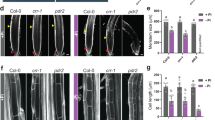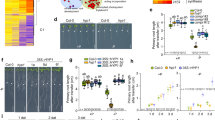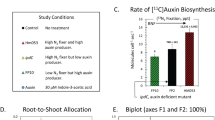Abstract
Iron is an essential but poorly bioavailable nutrient because of its low solubility, especially in alkaline soils. Here, we describe the discovery of a previously undescribed redox-active catecholic metabolite, termed sideretin, which derives from the coumarin fraxetin and is the primary molecule exuded by Arabidopsis thaliana roots in response to iron deficiency. We identified two enzymes that complete the biosynthetic pathway of fraxetin and sideretin. Chemical characterization of fraxetin and sideretin, and biological assays with pathway mutants, suggest that these coumarins are critical for iron nutrition in A. thaliana. Further, we show that sideretin production also occurs in eudicot species only distantly related to A. thaliana. Untargeted metabolomics of the root exudates of various eudicots revealed production of structurally diverse redox-active molecules in response to iron deficiency. Our results indicate that secretion of small-molecule reductants by roots may be a widespread and previously underappreciated component of reduction-based iron uptake.
This is a preview of subscription content, access via your institution
Access options
Access Nature and 54 other Nature Portfolio journals
Get Nature+, our best-value online-access subscription
$29.99 / 30 days
cancel any time
Subscribe to this journal
Receive 12 print issues and online access
$259.00 per year
only $21.58 per issue
Buy this article
- Purchase on Springer Link
- Instant access to full article PDF
Prices may be subject to local taxes which are calculated during checkout





Similar content being viewed by others
References
Hänsch, R. & Mendel, R. R. Physiological functions of mineral micronutrients (Cu, Zn, Mn, Fe, Ni, Mo, B, Cl). Curr. Opin. Plant Biol. 12, 259–266 (2009).
Balk, J. & Pilon, M. Ancient and essential: the assembly of iron-sulfur clusters in plants. Trends Plant Sci. 16, 218–226 (2011).
Palmer, C. M. & Guerinot, M. L. Facing the challenges of Cu, Fe and Zn homeostasis in plants. Nat. Chem. Biol. 5, 333–340 (2009).
Kobayashi, T. & Nishizawa, N. K. Iron uptake, translocation, and regulation in higher plants. Annu. Rev. Plant Biol. 63, 131–152 (2012).
Nozoye, T. et al. Phytosiderophore efflux transporters are crucial for iron acquisition in graminaceous plants. J. Biol. Chem. 286, 5446–5454 (2011).
Curie, C. et al. Maize yellow stripe1 encodes a membrane protein directly involved in Fe(iii) uptake. Nature 409, 346–349 (2001).
Murata, Y. et al. A specific transporter for iron(III)-phytosiderophore in barley roots. Plant J. 46, 563–572 (2006).
Takagi, S.-I. Naturally occurring iron-chelating compounds in oat- and rice-root washings. Soil Sci. Plant Nutr. 22, 423–433 (1976).
Santi, S. & Schmidt, W. Dissecting iron deficiency-induced proton extrusion in Arabidopsis roots. New Phytol. 183, 1072–1084 (2009).
Robinson, N. J., Procter, C. M., Connolly, E. L. & Guerinot, M. L. A ferric-chelate reductase for iron uptake from soils. Nature 397, 694–697 (1999).
Eide, D., Broderius, M., Fett, J. & Guerinot, M. L. A novel iron-regulated metal transporter from plants identified by functional expression in yeast. Proc. Natl. Acad. Sci. USA 93, 5624–5628 (1996).
Connolly, E. L., Fett, J. P. & Guerinot, M. L. Expression of the IRT1 metal transporter is controlled by metals at the levels of transcript and protein accumulation. Plant Cell 14, 1347–1357 (2002).
Römheld, V. & Marschner, H. Evidence for a specific uptake system for iron phytosiderophores in roots of grasses. Plant Physiol. 80, 175–180 (1986).
Lan, P. et al. iTRAQ protein profile analysis of Arabidopsis roots reveals new aspects critical for iron homeostasis. Plant Physiol. 155, 821–834 (2011).
Rodríguez-Celma, J. et al. Mutually exclusive alterations in secondary metabolism are critical for the uptake of insoluble iron compounds by Arabidopsis and Medicago truncatula. Plant Physiol. 162, 1473–1485 (2013).
Jin, C. W. et al. Iron deficiency-induced secretion of phenolics facilitates the reutilization of root apoplastic iron in red clover. Plant Physiol. 144, 278–285 (2007).
Sisó-Terraza, P., Rios, J. J., Abadía, J., Abadía, A. & Álvarez-Fernández, A. Flavins secreted by roots of iron-deficient Beta vulgaris enable mining of ferric oxide via reductive mechanisms. New Phytol. 209, 733–745 (2016).
Fourcroy, P. et al. Involvement of the ABCG37 transporter in secretion of scopoletin and derivatives by Arabidopsis roots in response to iron deficiency. New Phytol. 201, 155–167 (2014).
Schmid, N. B. et al. Feruloyl-CoA 6′-hydroxylase1-dependent coumarins mediate iron acquisition from alkaline substrates in Arabidopsis. Plant Physiol. 164, 160–172 (2014).
Schmidt, H. et al. Metabolome analysis of Arabidopsis thaliana roots identifies a key metabolic pathway for iron acquisition. PLoS One 9, e102444 (2014).
Kai, K. et al. Scopoletin is biosynthesized via ortho-hydroxylation of feruloyl CoA by a 2-oxoglutarate-dependent dioxygenase in Arabidopsis thaliana. Plant J. 55, 989–999 (2008).
Ziegler, J., Schmidt, S., Strehmel, N., Scheel, D. & Abel, S. Arabidopsis transporter ABCG37/PDR9 contributes primarily highly oxygenated coumarins to root exudation. Sci Rep. 7, 3704 (2017).
Mladěnka, P. et al. In vitro interactions of coumarins with iron. Biochimie 92, 1108–1114 (2010).
Murgia, I., Tarantino, D., Soave, C. & Morandini, P. Arabidopsis CYP82C4 expression is dependent on Fe availability and circadian rhythm, and correlates with genes involved in the early Fe deficiency response. J. Plant Physiol. 168, 894–902 (2011).
Kruse, T. et al. In planta biocatalysis screen of P450s identifies 8-methoxypsoralen as a substrate for the CYP82C subfamily, yielding original chemical structures. Chem. Biol. 15, 149–156 (2008).
Ray, A. B. et al. Structures of cleomiscosins, coumarinolignoids of Cleome viscosa seeds. Tetrahedron 41, 209–214 (1985).
Yuan, C. et al. Metal-free oxidation of aromatic carbon-hydrogen bonds through a reverse-rebound mechanism. Nature 499, 192–196 (2013).
Fujita, P. A. et al. The UCSC Genome Browser database: update 2011. Nucleic Acids Res. 39, D876–D882 (2011).
Kanehisa, M. & Goto, S. KEGG: Kyoto encyclopedia of genes and genomes. Nucleic Acids Res. 28, 27–30 (2000).
Amtmann, A., Bohnert, H. J. & Bressan, R. A. Abiotic stress and plant genome evolution: search for new models. Plant Physiol. 138, 127–130 (2005).
Smith, S. A., Beaulieu, J. M. & Donoghue, M. J. An uncorrelated relaxed-clock analysis suggests an earlier origin for flowering plants. Proc. Natl. Acad. Sci. USA 107, 5897–5902 (2010).
Susín, S. et al. Flavin excretion from roots of iron-deficient sugar beet (Beta vulgaris L.). Planta 193, 514–519 (1994).
Peters, N. K. & Verma, D. P. S. Phenolic compounds as regulators of gene expression in plant-microbe relations. Mol. Plant Microbe Interact. 3, 4–8 (1990).
Brown, J. C., Chaney, R. L. & Ambler, J. E. A new tomato mutant inefficient in the transport of iron. Physiol. Plant. 25, 48–53 (1971).
Brown, J. C. & Ambler, J. E. ‘Reductants’ released by roots of Fe-deficient soybeans. Agron. J. 65, 311–314 (1973).
Sisó-Terraza, P. et al. Accumulation and secretion of coumarinolignans and other coumarins in Arabidopsis thaliana roots in response to iron deficiency at high pH. Front. Plant Sci. 7, 1711 (2016).
Brutinel, E. D. & Gralnick, J. A. Microbial Metal Respiration 83–105. (Springer, Berlin and Heidelberg, 2012).
Price-Whelan, A., Dietrich, L. E. P. & Newman, D. K. Rethinking ‘secondary’ metabolism: physiological roles for phenazine antibiotics. Nat. Chem. Biol. 2, 71–78 (2006).
Yi, Y. & Guerinot, M. L. Genetic evidence that induction of root Fe(III) chelate reductase activity is necessary for iron uptake under iron deficiency. Plant J. 10, 835–844 (1996).
Vert, G. et al. IRT1, an Arabidopsis transporter essential for iron uptake from the soil and for plant growth. Plant Cell 14, 1223–1233 (2002).
Rajniak, J., Barco, B., Clay, N. K. & Sattely, E. S. A new cyanogenic metabolite in Arabidopsis required for inducible pathogen defence. Nature 525, 376–379 (2015).
Kilian, J. et al. The AtGenExpress global stress expression data set: protocols, evaluation and model data analysis of UV-B light, drought and cold stress responses. Plant J. 50, 347–363 (2007).
Dinneny, J. R. et al. Cell identity mediates the response of Arabidopsis roots to abiotic stress. Science 320, 942–945 (2008).
Fang, G., Bhardwaj, N., Robilotto, R. & Gerstein, M. B. Getting started in gene orthology and functional analysis. PLoS Comput. Biol. 6, e1000703 (2010).
Sainsbury, F., Thuenemann, E. C. & Lomonossoff, G. P. pEAQ: versatile expression vectors for easy and quick transient expression of heterologous proteins in plants. Plant Biotechnol. J. 7, 682–693 (2009).
Gibson, D. One-step enzymatic assembly of DNA molecules up to several hundred kilobases in size. Protoc. Exch. https://doi.org/doi:10.1038/nprot.2009.77 (2009).
Britton, H. T. S. & Robinson, R. A. The use of the antimony–antimonous oxide electrode in the determination of the concentration of hydrogen ions and in potenliometric titrations. The Prideaux–Ward universal buffer mixture. J. Chem. Soc. 0, 458–473 (1931).
Porra, R. J., Thompson, W. A. & Kriedemann, P. E. Determination of accurate extinction coefficients and simultaneous equations for assaying chlorophylls a and b extracted with four different solvents: verification of the concentration of chlorophyll standards by atomic absorption spectroscopy. Biochim. Biophys. Acta 975, 384–394 (1989).
Lampropoulos, A. et al. GreenGate: a novel, versatile, and efficient cloning system for plant transgenesis. PLoS One 8, e83043 (2013).
Clough, S. J. & Bent, A. F. Floral dip: a simplified method for Agrobacterium-mediated transformation of Arabidopsis thaliana. Plant J. 16, 735–743 (1998).
Pfaffl, M. W. A new mathematical model for relative quantification in real-time RT-PCR. Nucleic Acids Res. 29, e45 (2001).
Acknowledgements
This work was supported by US National Institutes of Health grant DP2 AT008321 and an HHMI–Simons Faculty Scholar Award to E.S.S. and by a grant from the Deutsche Forschungsgemeinschaft to N.v.W. (WI1728/21-1). J.R. was supported by an NIH Biotechnology Training Grant (T32 GM008412-20). We thank N. Schmid, J. Fuge, A. Bieber, H. Nierig, and M. Voges for valuable discussions and help with experiments; S. Elliott for advice on redox potential measurements; S. Fendorf for helpful discussions on rhizosphere iron; M. Kevin Brown and J. Du Bois for suggestions for chemical synthesis of sideretin; and T. Veltman for help with cyclic voltammetry measurements. We thank C. Curie (CNRS, IBIP, Montpellier) and M. B. Mudgett (Stanford University) for providing seeds.
Author information
Authors and Affiliations
Contributions
J.R., R.F.H.G., N.v.W., and E.S.S. designed experiments. J.R., R.F.H.G., and E.C. performed experiments. I.M. isolated homozygous T-DNA-insertion line cyp82C4-2. J.R., R.F.H.G., E.C., N.v.W., and E.S.S. analyzed data. J.R., R.F.H.G., N.v.W., and E.S.S. wrote the paper.
Corresponding author
Ethics declarations
Competing interests
The authors declare no competing interests.
Additional information
Publisher’s note: Springer Nature remains neutral with regard to jurisdictional claims in published maps and institutional affiliations.
Supplementary information
Supplementary Text and Figures
Supplementary Figures 1–19, Supplementary Table 1 and Supplementary Note
Supplementary Dataset 1
Ortholog analysis
Rights and permissions
About this article
Cite this article
Rajniak, J., Giehl, R.F.H., Chang, E. et al. Biosynthesis of redox-active metabolites in response to iron deficiency in plants. Nat Chem Biol 14, 442–450 (2018). https://doi.org/10.1038/s41589-018-0019-2
Received:
Accepted:
Published:
Issue Date:
DOI: https://doi.org/10.1038/s41589-018-0019-2
This article is cited by
-
Unraveling the interplay between root exudates, microbiota, and rhizosheath formation in pearl millet
Microbiome (2024)
-
Microbiome convergence enables siderophore-secreting-rhizobacteria to improve iron nutrition and yield of peanut intercropped with maize
Nature Communications (2024)
-
Ferric reduction by a CYBDOM protein counteracts increased iron availability in root meristems induced by phosphorus deficiency
Nature Communications (2024)
-
A CYBDOM protein impacts iron homeostasis and primary root growth under phosphate deficiency in Arabidopsis
Nature Communications (2024)
-
Revealing the nuclearity of iron citrate complexes at biologically relevant conditions
BioMetals (2024)



